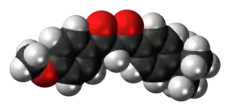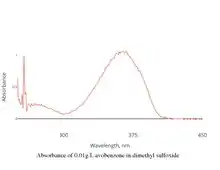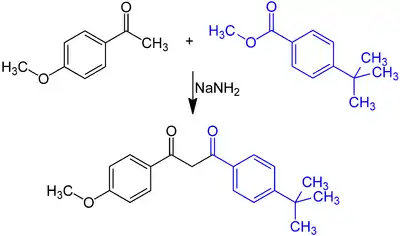Avobenzone
Avobenzone (trade names Parsol 1789, Milestab 1789, Eusolex 9020, Escalol 517, Neo Heliopan 357 and others, INCI Butyl Methoxydibenzoylmethane) is an oil-soluble ingredient used in sunscreen products to absorb the full spectrum of UVA rays.
 | |
 | |
| Names | |
|---|---|
| IUPAC name
1-(4-Methoxyphenyl)-3-(4-tert-butylphenyl)propane-1,3-dione | |
| Other names
butylmethoxydibenzoylmethane; 4-tert-butyl-4'-methoxydibenzoylmethane | |
| Identifiers | |
3D model (JSmol) |
|
| ChEMBL | |
| ChemSpider | |
| ECHA InfoCard | 100.067.779 |
| EC Number |
|
| KEGG | |
PubChem CID |
|
| UNII | |
CompTox Dashboard (EPA) |
|
| |
| |
| Properties | |
| C20H22O3 | |
| Molar mass | 310.39 g/mol |
| Appearance | colorless crystal |
| Supplementary data page | |
| Refractive index (n), Dielectric constant (εr), etc. | |
Thermodynamic data |
Phase behaviour solid–liquid–gas |
| UV, IR, NMR, MS | |
Except where otherwise noted, data are given for materials in their standard state (at 25 °C [77 °F], 100 kPa). | |
| Infobox references | |
History
Avobenzone was patented in 1973 and was approved in the EU in 1978. It was approved by the FDA in 1988. Its use is approved worldwide.
Properties
Pure avobenzone is a whitish to yellowish crystalline powder with a weak odor,[1] dissolving in isopropanol, dimethyl sulfoxide, decyl oleate, capric acid/caprylic, triglycerides and other oils. It is not soluble in water.
Avobenzone is a dibenzoylmethane derivative. Avobenzone exists in the ground state as a mixture of the enol and keto forms, favoring the chelated enol.[2] This enol form is stabilized by intramolecular hydrogen-bonding within the β-diketone.[3] Its ability to absorb ultraviolet light over a wider range of wavelengths than many other sunscreen agents has led to its use in many commercial preparations marketed as "broad spectrum" sunscreens. Avobenzone has an absorption maximum of 357 nm.[4]
It is subject to keto-enol tautomerism and exists predominantly enol when dissolved. Upon UV radiation, it may convert to keto form, while converting back to enol form after placing in dark.[5]

Stability
Avobenzone is sensitive to the properties of the solvent, being relatively stable in polar protic solvents and unstable in nonpolar environments. Also, when it is irradiated with UVA light, it generates a triplet excited state in the keto form which can either cause the avobenzone to degrade or it can transfer energy to biological targets and cause deleterious effects.[2]
Avobenzone has been shown to degrade significantly in light, resulting in less protection over time.[6][7][8] The UV-A light in a day of sunlight in a temperate climate is sufficient to break down most of the compound. Data presented to the Food and Drug Administration by the Cosmetic, Toiletry and Fragrance Association indicates a −36% change in avobenzone's UV absorbance following one hour of exposure to sunlight.[9] This degradation can be reduced by using a photostabilizer, like octocrylene. Other photostabilizers include:
- 4-Methylbenzylidene camphor (USAN Enzacamene)
- Tinosorb S (USAN Bemotrizinol, INCI Bis-Ethylhexyloxyphenol Methoxyphenyl Triazine)
- Tinosorb M (USAN Bisoctrizole, INCI Methylene Bis-Benzotriazolyl Tetramethylbutylphenol)
- Butyloctyl Salicylate (Tradename HallBrite BHB - )
- Hexadecyl Benzoate
- Butyloctyl Benzoate
- HallBrite PSF (INCI Undecylcrylene DimethiconeE)[10]
- Mexoryl SX (USAN Ecamsule, INCI Terephthalylidene Dicamphor Sulfonic Acid)
- Synoxyl HSS (INCI Trimethoxybenzylidene Pentanedione)[11]
- Corapan TQ (INCI Diethylhexyl 2,6-Naphthalate)[12]
- Parsol SLX (INCI Polysilicone-15)[13]
- Oxynex ST (INCI Diethylhexyl Syringylidene Malonate[14]
- Polycrylene (INCI Polyester-8)[15]
- SolaStay S1 (INCI Ethylhexyl Methoxycrylene)[16]
Complexing avobenzone with cyclodextrins may also increase its photostability.[17] Formulations of avobenzone with hydroxypropyl-beta-cyclodextrin have shown significant reduction in photo-induced degradation, as well as increased transdermal penetration of the UV absorber.[18]
According to some studies, "the most effective sunscreens contain avobenzone and titanium dioxide."[19][20] Avobenzone can degrade faster in light in combination with mineral UV absorbers like zinc oxide and titanium dioxide, though with the right coating of the mineral particles this reaction can be reduced.[21] A manganese doped titanium dioxide may be better than undoped titanium dioxide to improve avobenzone's stability.[22]
Various
As an enolate, avobenzone forms with heavy metal ions (such as Fe3+) colored complexes, and chelating agents can be added to suppress them. Stearates, aluminum, magnesium and zinc salts can lead to poorly soluble precipitates.[1] Manufacturers also recommend to avoid the inclusion of iron and ferric salts, heavy metals, formaldehyde donors and PABA and PABA esters. The makers of Coppertone advise that avobenzone binds iron and can cause staining of clothes washed in iron-rich water. The staining properties of sunblock made with avobenzone are particularly noticeable on fiberglass boats with white gelcoat.
Avobenzone also reacts with boron trifluoride to form a stable crystalline complex that is highly fluorescent under UV irradiation. The emission color of the crystals depends on the molecular packing of the boron avobenzone complex. The photoluminescence may also be altered by mechanical force in the solid state, resulting in a phenomenon called "mechanochromic luminescence". The altered emission color recovers itself slowly at room temperature or more swiftly at higher temperatures.[23]
Absorbance Spectrum
Avobenzone has a peak absorbance around 360 nm when dissolved. The peak may shift slightly depending on the solvent.

Preparation
The compound is prepared by reacting 4-tert-butylbenzoic methyl ester (from 4-tert-butylbenzoic acid by esterification with methanol) with 4-methoxyacetophenone in toluene in the presence of sodium amide via Claisen condensation.[24]

According to a recent patent application,[25] yields of up to 95% are obtained with the same starting materials in toluene in the presence of potassium methoxide.
Safety
Although avobenzone is considered safe, disintegration products may have significant health impacts and persist in the environment. A recent study at Lomonosov Moscow State University found that chlorinated water and ultraviolet light can cause avobenzone to disintegrate into various other organic compounds, including; aromatic acids, aldehydes, phenols, and acetophenones which may have adverse health effects.[26][27][28]
See also
Notes
- "Making Cosmetics®, Avobenzone". Makingcosmetics.com. Retrieved 2015-07-29.
- Paris C, Lhiaubet-Vallet V, Jimenez O, Trullas C, Miranda M (January–February 2009). "A Blocked Diketo Form of Avobenzone: Photostability, Photosensitizing Properties and Triplet Quenching by a Triazine-derived UVB-filter". Photochemistry and Photobiology. 85 (1): 178–184. doi:10.1111/j.1751-1097.2008.00414.x. PMID 18673327.
- Zawadiak J, Mrzyczek M (October 2012). "Influence Of Substituent On UV Absorption And Keto–Enol Tautomerism Equilibrium Of Dibenzoylmethane Derivatives". Spectrochim Acta a Mol Biomol Spectrosc. 96: 815–819. Bibcode:2012AcSpA..96..815Z. doi:10.1016/j.saa.2012.07.109. PMID 22925908.
- Vielhaber G, Grether-Beck S, Koch O, Johncock W, Krutmann J (March 2006). "Sunscreens with an absorption maximum of > or =360 nm provide optimal protection against UVA1-induced expression of matrix metalloproteinase-1, interleukin-1, and interleukin-6 in human dermal fibroblasts". Photochem Photobiol Sci. 5 (3): 275–282. doi:10.1039/b516702g. PMID 16520862.
- G. J. Mturi, B. S. Martincigh (2008), "Photostability of the sunscreening agent 4-tert-butyl-4-methoxydibenzoylmethane (avobenzone) in solvents of different polarity and proticity", J. Photochem. Photobiol.: Chemistry, 200 (2–3), pp. 410–420, doi:10.1016/j.jphotochem.2008.09.007
- Chatelain E, Gabard B (September 2001). "Photostabilization of Butyl methoxydibenzoylmethane (Avobenzone) and Ethylhexyl methoxycinnamate by Bis-ethylhexyloxyphenol methoxyphenyl triazine (Tinosorb S), a new UV broadband filter". Photochemistry and Photobiology. 74 (3): 401–406. doi:10.1562/0031-8655(2001)074<0401:POBMAA>2.0.CO;2. ISSN 0031-8655. PMID 11594052.
-
 Tarras-Wahlberg N, Stenhagen G, Larko O, Rosen A, Wennberg AM, Wennerstrom O (October 1999). "Changes in ultraviolet absorption of sunscreens after ultraviolet irradiation". Journal of Investigative Dermatology. 113 (4): 547–553. doi:10.1046/j.1523-1747.1999.00721.x. PMID 10504439.
Tarras-Wahlberg N, Stenhagen G, Larko O, Rosen A, Wennberg AM, Wennerstrom O (October 1999). "Changes in ultraviolet absorption of sunscreens after ultraviolet irradiation". Journal of Investigative Dermatology. 113 (4): 547–553. doi:10.1046/j.1523-1747.1999.00721.x. PMID 10504439. - Wetz F, Routaboul C, Denis A, Rico-Lattes I (Mar–Apr 2005). "A new long-chain UV absorber derived from 4-tert-butyl-4'-methoxydibenzoylmethane: absorbance stability under solar irradiation". Journal of Cosmetic Science. 56 (2): 135–148. doi:10.1562/2004-03-09-ra-106. PMID 15870853.
- "CTFA letter re: Tentative Final Monograph for OTC Sunscreen" (PDF). Food and Drug Administration.
- "Archived copy". Archived from the original on 2011-10-02. Retrieved 2011-05-25.CS1 maint: archived copy as title (link)
- RK Chaudhuri, MA Ollengo, P Singh and BS Martincigh, 3-(3,4,5-Trimethoxybenzylidene)-2,4-pentanedione: Design of a Novel Photostabilizer with In-vivo SPF Boosting Properties and Its Use in Developing Broad-spectrum Sunscreen Formulations, International Journal of Cosmetic Science, 39(1):25-35, 2017; First published 29 June 2016 | doi: 10.1111/ics.12344
- Bonda C.; Steinberg D. C. (2000). "A new photostabilizer for full spectrum sunscreens". Cosmetics & Toiletries. 115 (6): 37–45.
- http://www.dsm.com/en_US/downloads/dnp/Parsol_SLX_Skin.pdf
- Chaudhuri RK, Lascu Z, Puccetti G, Deshpande AA, Paknikar SK (May–Jun 2006). "Design of a photostabilizer having built-in antioxidant functionality and its utility in obtaining broad-spectrum sunscreen formulations". Photochemistry and Photobiology. 82 (3): 823–828. doi:10.1562/2005-07-15-RA-612. PMID 16492073. S2CID 23707972.
- http://www.hallstar.com/techdocs/Polycrylene&CorapanTQAvobenzoneStabilization.pdf
- "Product Information Sheet: SolaStay S1". The HallStar Company. Archived from the original on 2 October 2011. Retrieved 16 February 2010.
- Scalia S, Simeoni S, Barbieri A, Sostero S (November 2002). "Influence of hydroxypropyl-beta-cyclodextrin on photo-induced free radical production by the sunscreen agent, butyl-methoxydibenzoylmethane". Journal of Pharmacy and Pharmacology. 54 (11): 1553–1558. doi:10.1211/002235702207. PMID 12495559.
- Yang J, Wiley C, Godwin D, Felton L (June 2008). "Influence of hydroxypropyl-β-cyclodextrin on transdermal penetration and photostability of avobenzone". European Journal of Pharmaceutics and Biopharmaceutics. 69 (2): 605–612. doi:10.1016/j.ejpb.2007.12.015. PMID 18226883.
- Warwick L. Morison, M.D. (March 11, 2004). "Photosensitivity". The New England Journal of Medicine. 350 (11): 1111–1117. doi:10.1056/NEJMcp022558. PMID 15014184.
- "Sunscreen Drug Products for Over-the-Counter use; Marketing Status of Products Containing Avobenzone; Enforcement Policy" (PDF). US Food and Drug Administration. 1997-04-30. p. 23354. Archived (PDF) from the original on 2007-02-26. Retrieved 2007-06-03.
- Stability Study of Avobenzone with Inorganic Sunscreens, Kobo Products Poster, 2001, Online version Archived May 7, 2007, at the Wayback Machine
- Wakefield G, Lipscomb S, Holland E, Knowland J (July 2004). "The effects of manganese doping on UVA absorption and free radical generation of micronised titanium dioxide and its consequences for the photostability of UVA absorbing organic sunscreen components". Photochem Photobiol Sci. 3 (7): 648–652. doi:10.1039/b403697b. PMID 15238999.
- Zhang G; Lu J; Sabat M; Fraser, CL (February 2010). "Polymorphism and Reversible Mechanochromic Luminescence for Solid-State Difluoroboron Avobenzone". Journal of the American Chemical Society. 132 (7): 2160–2162. doi:10.1021/ja9097719. PMID 20108897. S2CID 30823815.
- US 0
- US 0
- "Sunscreen creams break down into dangerous chemical compounds under the sunlight". EurekAlert!. Retrieved 2017-06-30.
- Wang, Cheng; Bavcon Kralj, Mojca; Košmrlj, Berta; Yao, Jun; Košenina, Suzana; Polyakova, Olga V.; Artaev, Viatcheslav B.; Lebedev, Albert T.; Trebše, Polonca (September 2017). "Stability and removal of selected avobenzone's chlorination products". Chemosphere. 182: 238–244. Bibcode:2017Chmsp.182..238W. doi:10.1016/j.chemosphere.2017.04.125. PMID 28500968.
- Trebše, Polonca; Polyakova, Olga V.; Baranova, Maria; Kralj, Mojca Bavcon; Dolenc, Darko; Sarakha, Mohamed; Kutin, Alexander; Lebedev, Albert T. (2016-09-15). "Transformation of avobenzone in conditions of aquatic chlorination and UV-irradiation". Water Research. 101: 95–102. doi:10.1016/j.watres.2016.05.067. PMID 27258620.